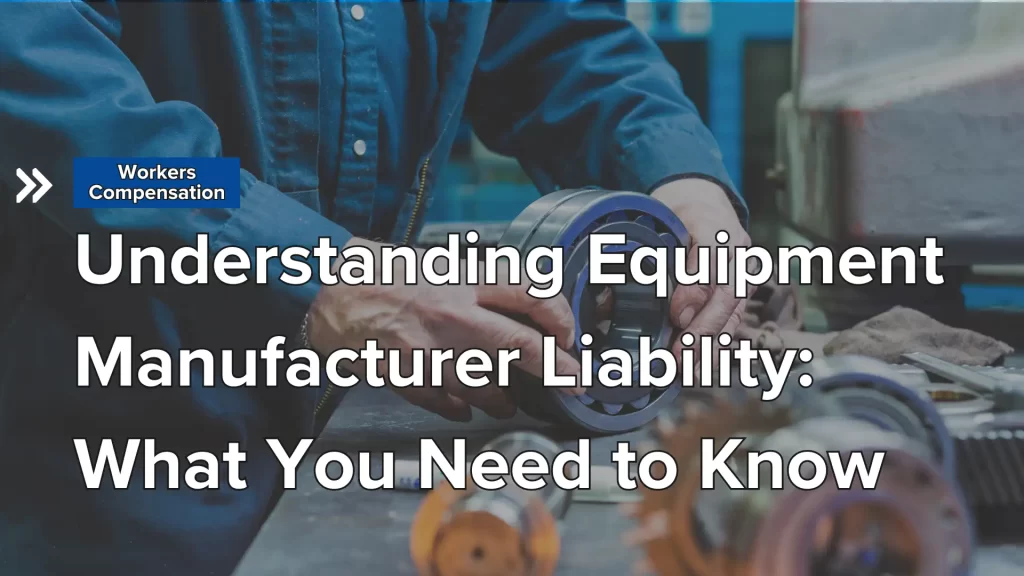
What if you experience a work injury due to defective equipment? Equipment manufacturer liability determines responsibility when a piece of equipment fails and causes harm. This article explains who can be held accountable, the legal principles involved, the types of defects, and actions to take if you are an injured worker.
Legal Responsibilities of Equipment Manufacturers
When a product goes awry, pinpointing the source of responsibility is a multi-faceted task. Equipment manufacturer liability is a legal cornerstone, ensuring those who produce or sell products are held to account for the safety of their goods. Whether it’s a tool that breaks under normal use or a machine that malfunctions, causing harm, understanding the nuances of liability is the first step toward justice and compensation.
Definition of Equipment Manufacturer Liability
Equipment manufacturer liability casts a wide net across the production chain, implicating everyone from the component parts producer involved in the manufacturing process to the manufacturer, the distributor, the wholesaler, and the retailer.
This broad definition underscores the belief that safety should be the hallmark of any product or power tool on the market.
It’s not just about tangible items; this liability extends to all manner of products, ensuring that every link in the chain of commerce is accountable for the safety of the end user.
Legal Basis for Equipment Manufacturer Liability
Grounded in the principles of tort law, product liability, also known as product liability law, serves as the framework for holding manufacturers accountable. It’s through this lens that we evaluate the duty of care owed by product makers and their adherence to it. Strict liability, a key concept in these cases, strips away considerations of intent, focusing solely on the existence of a defect and the consequent injury.
Despite the lack of a unified federal law, product liability laws can maintain product safety standards. Along with safety standards and manufacturer responsibility laws, the legal system provides various avenues to address grievances stemming from product failures.
Types of Equipment Defects
Venturing deeper into the realm of product liability lawsuits, one must understand the types of defects that can ensue. Defects can arise during any phase of a product’s life, from initial design to final marketing, and they are generally categorized into three types: manufacturing, design, and marketing defects. Each carries its implications and challenges for proving liability.
Manufacturing Defects
A manufacturing defect is a departure from a product’s intended design, often due to errors on the assembly line or in the sourcing of materials. Such a flaw might make a single product dangerous, even when the overall product line is safe. These product defects are the anomalies that slip through the cracks—the ones that, despite best efforts, end up in the hands of consumers.
Design Defects
On the other hand, a design defect is an intrinsic flaw that affects an entire product line, making every item potentially hazardous, regardless of flawless manufacturing. These defects often require a more complex analysis involving industry standards and risk-utility balancing to determine whether a safer, practicable alternative design is possible.
Marketing Defects
The last category, marketing defects, arises when a product’s risks are not adequately communicated to the consumer. If necessary warnings or instructions are not provided, misuse and accidents can occur, making the manufacturer accountable for a breach of warranty.
It’s about ensuring that all potential dangers are transparent so that users can make informed decisions.
Common Injuries from Defective Equipment
The consequences of equipment failure can be severe, with the potential for life-altering injuries or even fatalities. From the construction site to the home workshop, defective equipment can cause serious harm, and it’s essential to recognize the risks associated with using any product.
Acknowledging these risks is the first step in preventing injury and preparing for the possibility of legal action.
Serious Injuries Caused by Defective Equipment
Serious injuries from defective equipment are as varied as the equipment itself. Crush injuries from heavy machinery, amputations from malfunctioning tools, and electrocution from faulty wiring are just a few examples. These injuries can be sudden and devastating, changing lives in an instant and leaving lasting physical and emotional scars.
Long-Term Health Impacts
Beyond the immediate aftermath, defective equipment can lead to chronic health issues, such as persistent pain, limited mobility, and neurological conditions. Psychological effects, like PTSD, can also take a toll on victims and their families, compounding the physical injuries with emotional trauma.
These long-term impacts underscore the critical nature of holding manufacturers accountable for their products.
Proving Liability in Equipment Defect Cases
Proving liability in equipment defect cases is a complex process that demands a clear demonstration of the defect and its direct link to the injury. Establishing liability is key to ensuring that victims receive the justice and compensation they deserve. It’s a legal battle that requires a meticulous approach to evidence and argumentation.
Establishing a Prima Facie Case
To establish a prima facie case, a victim must prove that the product was defective, the defect was present when it left the manufacturer’s control, and that it directly caused the injury. This establishes the basic framework for a product liability claim and sets the stage for further legal action.
Evidence Collection and Preservation
Evidence collection and preservation are critical components of any product liability case. From the defective product itself to medical records and witness statements, every piece of evidence serves to bolster the victim’s claim. Proper documentation and preservation of this evidence can make or break a case.
Expert Testimony and Analysis
In many cases, expert testimony and analysis are crucial for clarifying the technical aspects of a defect and its role in causing the injury. Experts bring a level of detail and understanding to the table that can significantly influence the outcome of a case.
Steps to Take if Injured by Defective Equipment
If you find yourself injured by defective equipment, it’s essential to take immediate and decisive action. From seeking medical attention to documenting the incident and contacting an experienced attorney, these steps will help protect your rights and set the foundation for your product liability claim.
Immediate Actions Post-Injury
After an injury, your priority should be your safety and health. Seek medical attention to both treat your injuries and document them for any future claims. Reporting the incident to authorities or your employer is also crucial for official record-keeping.
Documenting the Incident
Documenting the incident is a critical step in building your case. Take photographs of the scene and the defective product, and keep all related paperwork, including purchase receipts and packaging. These items will serve as evidence and support your claim.
Maximizing Compensation for Injuries
 Maximizing compensation after an injury caused by a piece of defective or faulty equipment involves a strategic approach to documenting your equipment manufacturer liability. This includes calculating damages and choosing between negotiating a settlement or going to trial. Experienced legal representation can facilitate this process, significantly increasing the likelihood of a favorable outcome.
Maximizing compensation after an injury caused by a piece of defective or faulty equipment involves a strategic approach to documenting your equipment manufacturer liability. This includes calculating damages and choosing between negotiating a settlement or going to trial. Experienced legal representation can facilitate this process, significantly increasing the likelihood of a favorable outcome.
Investigating Claims Thoroughly
A thorough investigation of your claim is vital for identifying all liable parties and potential sources of compensation. It’s not uncommon for multiple parties to share the responsibility for a defective product, and a comprehensive investigation can uncover these contributors to maximize your compensation.
Calculating Damages
Calculating damages accurately is essential for ensuring you receive fair compensation. This includes your medical bills and expenses, lost wages, and non-economic factors like pain and suffering.
Maintaining detailed records of all expenses related to your injury will aid in this calculation.
Negotiating Settlements vs. Going to Trial
The decision to negotiate a settlement or go to trial is a significant one, with each option carrying its risks and potential benefits. While a trial may offer the possibility of a larger award, it also comes with the uncertainty of a jury’s decision.
Careful consideration and legal advice can guide this decision.
Frequently Asked Questions
What constitutes a manufacturing defect?
A manufacturing defect occurs when there is an error in the making or assembling of a product, resulting in it being different from its intended design and potentially dangerous to use.
How can I prove a product had a design defect?
To prove a product had a design defect, you can demonstrate that the product was inherently unsafe due to its design and show that there was a feasible, safer alternative design available. This can help establish the presence of a design defect.
What should I do immediately after being injured by defective equipment?
Make sure to prioritize your safety and seek medical attention to document and treat your injuries. Preserve the defective product, take photographs of the scene, and report the incident to the appropriate authorities. These steps can be crucial in handling the situation effectively.
When should I contact an attorney if I’ve been injured by a defective product?
You should contact an experienced attorney as soon as possible after the incident to help navigate the legal process, preserve evidence, and begin building your case. Timing is crucial in these situations, so reaching out early can be beneficial.
Can I still receive compensation if I was partially at fault for my injury caused by defective equipment?
Yes, you may still be able to receive compensation. However, the amount could be reduced based on your percentage of fault. It’s best to consult with a legal expert for specific advice.
Contact a Chicago Workers Compensation Attorney
As we’ve explored, the aftermath of an injury caused by defective equipment requires an understanding of manufacturer liability, knowledge of the types of defects, and a clear approach to legal action. At JJ Legal, our Chicago workers’ compensation attorney is taking the right steps from the moment of injury.
Our team documents everything and seeks experienced legal counsel, ensuring that justice is served. Equip yourself with this knowledge of workers’ compensation claims. We can help you prepare to stand up for your rights and pursue the compensation you deserve. Call us at 312-200-2000 for a free consultation with our injury attorneys in pursuing claims against equipment manufacturers.



